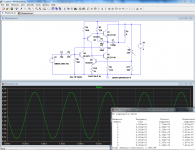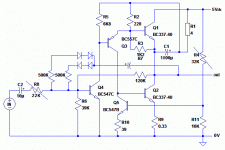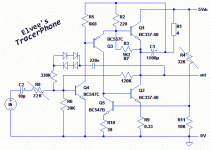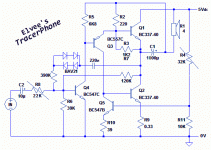Bravo!!
THD doesn't explain why that's top tier audio, but feedback explains it:
With 4 batteries (4v to 6v range) or MC7805, the power noise rejection is mostly handled externally instead of polluting the audio feedback. The Singleton/NTP/SSA with the feedback doing "Only Audio" then doesn't engage the very high ear sensitivity for harmonic comparisons/cancellations so easily irritated by LTP types. With both Singleton and Clean power, your amp has 100% detail with Added 0.15% texture (0% masking). Bravo for making top-tier audio with just 5 transistors!
But, there's a problem: Very few sources are good enough to push a high resolution adder, and those that are, have a buffered output. To negate the differences between have and have-not sources, this little amp needs a buffered input.
THD doesn't explain why that's top tier audio, but feedback explains it:
With 4 batteries (4v to 6v range) or MC7805, the power noise rejection is mostly handled externally instead of polluting the audio feedback. The Singleton/NTP/SSA with the feedback doing "Only Audio" then doesn't engage the very high ear sensitivity for harmonic comparisons/cancellations so easily irritated by LTP types. With both Singleton and Clean power, your amp has 100% detail with Added 0.15% texture (0% masking). Bravo for making top-tier audio with just 5 transistors!
But, there's a problem: Very few sources are good enough to push a high resolution adder, and those that are, have a buffered output. To negate the differences between have and have-not sources, this little amp needs a buffered input.
Last edited:
Thank you!It could work, but you only need one 500K resistor. Just tie the two diodes together. BTW with 500K the effect will be homeopathic: a very, very soft clipper. For 500K, a capacitor value of 100n is OK. Make it proportionally larger if you reduce the 500K resistor.
A soft clipper is mostly a "no free lunch" arrangement because they also make noise, so I was aiming for approximately 1db (neither soft clipping much nor making much noise). But, headroom for 1db more output is same as 1/3rd more power. And that's okay for the price of a couple of diodes and resistors. The resistor value may need to be changed a bit. So, thank you for the guidelines.
Last edited:
Schematic reflecting the minor touch-ups.
I put a 220n cap, supporting soft clip resistor values from 220k to 1m, so nobody has to change their cap when fine tuning the resistor current and diode voltage. The soft clip shown is more abrupt, but better protection.
The soft clip shown is more abrupt, but better protection.
What I didn't show (because it would make the schematic look messy if I did) was the possibility of a staggered effect by adding 1n5819, 1m shunt, 1n5819, 1m shunt, repeatedly to "homeopathic: a very, very soft clipper" <-several of those in parallel but each with a slightly higher 0.2v engagement point to create a rounded taper (works like car shock absorber) that eventually adds up to effective without the abrupt noise. I didn't show it because a transparent LDR device would be more preferable than stacks of very mild soft clippers. But I wanted to leave a note about the tapered soft clip, just in case someone wants to combine less abrupt with more effective.
I put a 220n cap, supporting soft clip resistor values from 220k to 1m, so nobody has to change their cap when fine tuning the resistor current and diode voltage.
What I didn't show (because it would make the schematic look messy if I did) was the possibility of a staggered effect by adding 1n5819, 1m shunt, 1n5819, 1m shunt, repeatedly to "homeopathic: a very, very soft clipper" <-several of those in parallel but each with a slightly higher 0.2v engagement point to create a rounded taper (works like car shock absorber) that eventually adds up to effective without the abrupt noise. I didn't show it because a transparent LDR device would be more preferable than stacks of very mild soft clippers. But I wanted to leave a note about the tapered soft clip, just in case someone wants to combine less abrupt with more effective.
Attachments
Last edited:
So far, I got it up and running. It sure is quiet with no input. And it plays clearly! The trimmers (R4, R8) work as expected. I didn't install the soft clip. When I apply input with the MP3 player, the problem is that the output is not really any more powerful than the MP3 player without the amp. I've got a lot less power than an op-amp would do on 5v. SO, I'm mystified about that.
I added a 10k input load. Was that an error?
Also, I don't quite know how to measure the bias or set R4 although I did figure out to turn that dial till the outputs cool off and stay cool. I did use the 5 transistors, but it is still pedantic on voltage.
Tried changing R6 to 16k and dialing the voltage up to 9.01v, and that worked for a bit more headroom and it still clearly and louder, although it took me half an hour to set the trimmers. Still haven't got 1 watt of power yet though. I must have made a construction error somewhere.
I added a 10k input load. Was that an error?
Also, I don't quite know how to measure the bias or set R4 although I did figure out to turn that dial till the outputs cool off and stay cool. I did use the 5 transistors, but it is still pedantic on voltage.
Tried changing R6 to 16k and dialing the voltage up to 9.01v, and that worked for a bit more headroom and it still clearly and louder, although it took me half an hour to set the trimmers. Still haven't got 1 watt of power yet though. I must have made a construction error somewhere.
- Home
- Amplifiers
- Headphone Systems
- A small, low-voltage, battery operated amplifier



